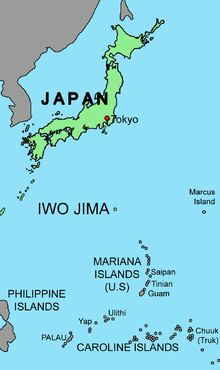- North Field (Iwo Jima)
-
North Field (Iwo Jima)

Part of Twentieth Air Force Type Military airfield Coordinates 24°47′05″N 141°19′27″E / 24.78472°N 141.32417°E Built Prior to 1944 In use 1944–present Controlled by United States Army Air Forces (1945–1953)
Japan Self-Defense Forces (1953–present) (IATA: IWO, ICAO: RJAW)Iwo Jima Air Base
North Field
Iwoto Airport
硫黄島飛行場
Iōtō HikōjōIATA: IWO – ICAO: RJAW Summary Airport type Military Owner Ministry of Defense, Japan Operator JMSDF Location Iwo Jima, Ogasawara, Tokyo Elevation AMSL 384 ft / 117 m Coordinates 24°47′03″N 141°19′21″E / 24.78417°N 141.3225°ECoordinates: 24°47′03″N 141°19′21″E / 24.78417°N 141.3225°E Map Location in Japan Runways Direction Length Surface m ft 07/25 2,650 8,694 Asphalt Source: Japanese AIP at AIS Japan[1] North Field or Iwo Jima Air Base (IATA: IWO, ICAO: RJAW) is a World War II airfield on Iwo Jima in the Bonin Islands, located in the Central Pacific. The Bonin Islands are part of Japan. Today, the airfield is operated by the Japan Self-Defense Forces as a military airfield.
Contents
History
- See also: Battle of Iwo Jima
Located south and west of the midpoint between Tokyo and Saipan, the island of Iwo Jima was needed by the United States Army Air Force Twentieth Air Force as an emergency landing facility for its B-29 Superfortress strategic bombing campaign against the Empire of Japan.
United States Marines landed on Iwo Jima February 19, 1945. The first day saw 2,400 American casualties. During the battle U.S. Marines, sailors and soldiers killed an estimated 20,000 Japanese and captured over 1,000 prisoners. On March 25 the Battle of Iwo Jima was declared over and the island secured, although mopping up continued until July. United States Army units, including the 147th Infantry also participated in the battle.
North Field was a Japanese airfield which was repaired and lengthened by American forces to accommodate B-29s making emergency landings. Central and North Fields on Iwo Jima handled over 2,400 emergency landings by American aircraft. It was also the headquarters for VII Fighter Command (assigned to Twentieth Air Force) from March 1 – December 1, 1945, along with the intelligence-gathering 41st Photographic Reconnaissance Squadron from August though mid-September 1945. Operational fighter squadrons which performed B-29 escort missions from North Field were:
- 506th Fighter Group, April 24 – December 3, 1945
- 414th Fighter Group, July 7 – December 23, 1945
- 21st Fighter Group, July 16 – December 4, 1945
- 548th Night Fighter Squadron, March 5 – June 12, 1945
- 549th Night Fighter Squadron, (Ground Echelon), March 14, 1945 – February 5, 1946
After the war, North Field stayed in American hands until after the Korean War, when it was turned over to the Japan Self-Defense Forces as an interceptor base. It continues in that role today.
See also
- USAAF in the Central Pacific
- Central Field
References
 This article incorporates public domain material from websites or documents of the Air Force Historical Research Agency.
This article incorporates public domain material from websites or documents of the Air Force Historical Research Agency.- Maurer, Maurer (1983). Air Force Combat Units Of World War II. Maxwell AFB, Alabama: Office of Air Force History. ISBN 0-89201-092-4.
- www.pacificwrecks.com
External links
Japanese airports First class airports Chūbu Centrair International · Kansai International · Narita International · Osaka International (Itami) · Tokyo International (Haneda)Second class airports Third class airports Aguni · Amami · Aomori · Fukue · Fukui · Fukushima · Hachijojima · Hanamaki · Hateruma · Ibaraki (Hyakuri) · Iejima · Iki · New Ishigaki · Ishigaki · Iwami · Izumo · Kamigoto · Kerama · Kikai · Kitadaito · Kobe · Kōzushima · Kumejima · Matsumoto · Memanbetsu · Minami-Daito · Miyakejima · Miyako · Monbetsu · Nakashibetsu · Nanki-Shirahama · New Tanegashima · Niijima · Noto · Odate-Noshiro · Ojika · Okayama · Oki · Okinoerabu · Okushiri · Oshima · Rebun · Rishiri · Sado · Saga · Shimojishima · Shizuoka · Shonai · Tarama · Tokunoshima · Tottori · Toyama · Tsushima · Yakushima · Yonaguni · YoronOther airports Amakusa · Chofu · Hiroshima-Nishi · Honda · Kasaoka · Kōnan · Komatsu* · Makurazaki · Miho-Yonago* · Misawa Air Base/Misawa Airport* · Nagoya · Oitakenou · Okadama* · Tajima · Teshikaga · Tokushima*
(*: dual military/civilian use)Military only airfields Akeno · Asahikawa · Ashiya · Atsugi · Chitose · Futenma · Gifu · Hachinohe · Hamamatsu · Hōfu · Hyakuri · Iruma · Iwakuni · Kanoya · Matsushima · Metabaru · Iwo Jima · Kadena · Kasumigaura · Kasuminome · Kisarazu · Minami Torishima · Nyutabaru · Ōminato · Ozuki · Shimofusa · Shizuhama · Tachikawa · Tateyama · Tokachi · Tsuiki · Utsunomiya · YokotaHeliports Defunct airports Categories:- Airports in Japan
- Japan Maritime Self-Defense Force
- Transport in the Greater Tokyo Area
- Airfields of the United States Army Air Forces in Occupied Japan
Wikimedia Foundation. 2010.


